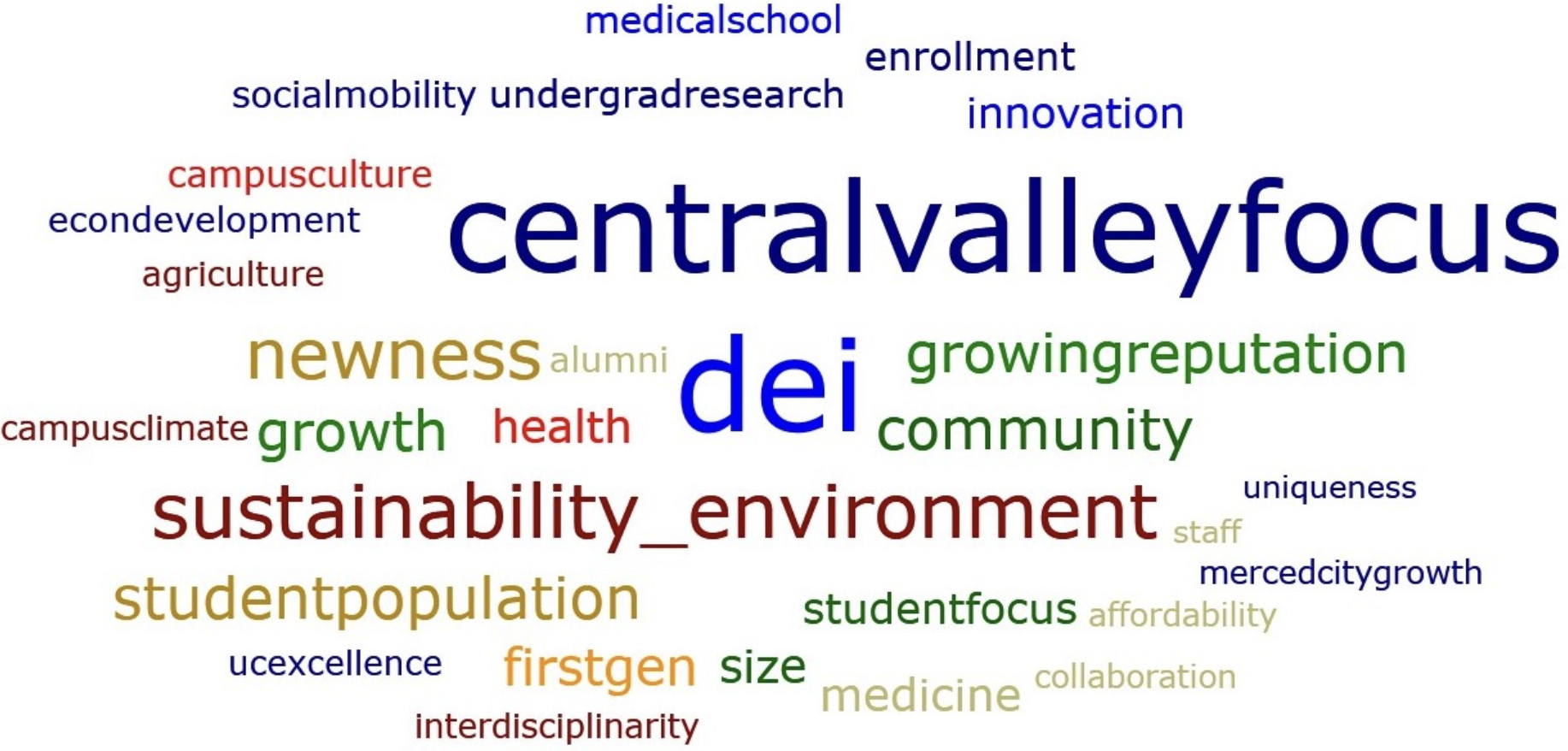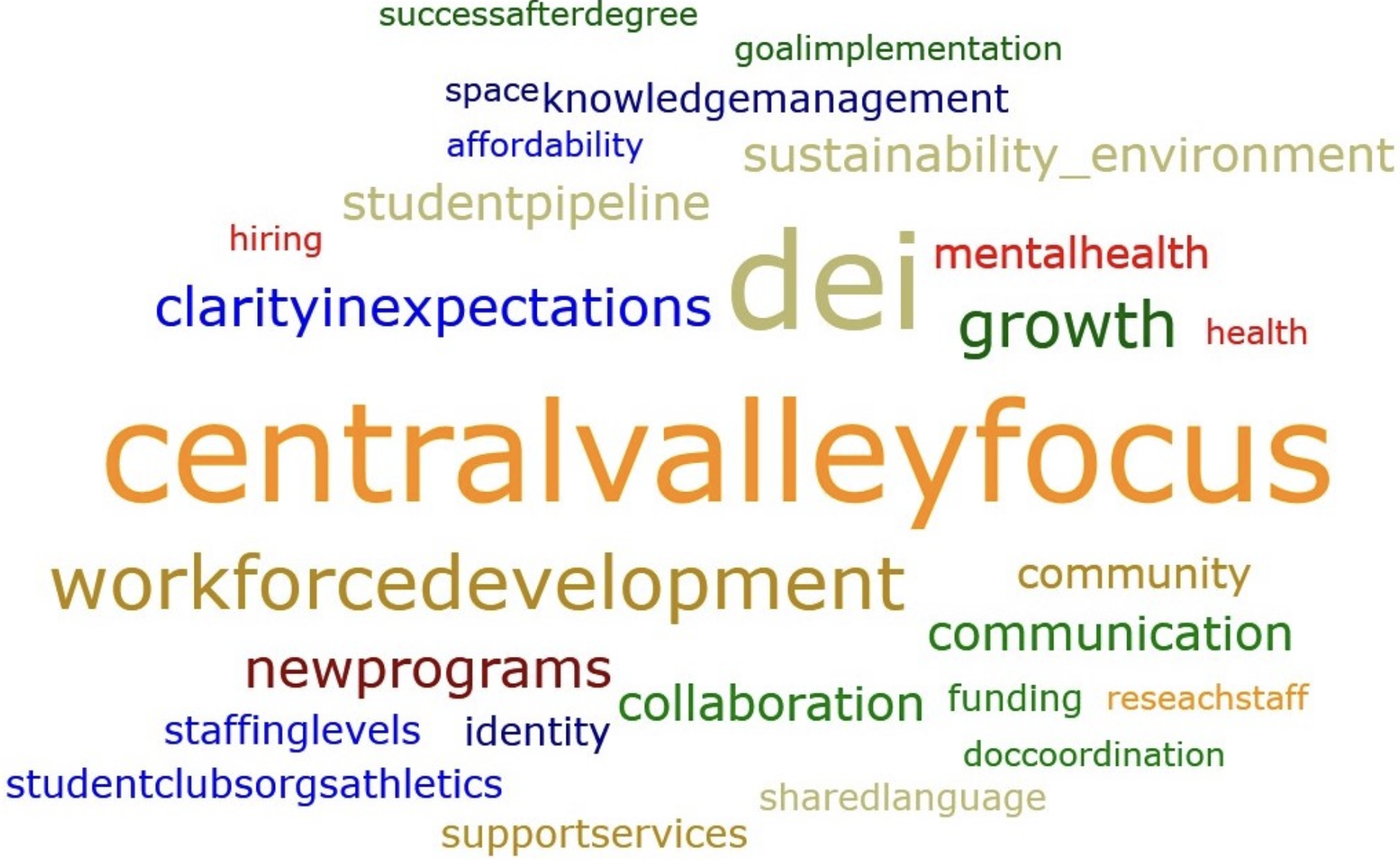In August 2020, Chancellor Juan Sánchez Muñoz asked Executive Vice Chancellor and Provost Gregg Camfield to lead the university’s first comprehensive strategic planning process. The objective was to integrate the various efforts across campus to produce goals and strategies to guide UC Merced’s development over the next 10 years.
Why is a comprehensive strategic plan important?
The strategic planning effort held in 2020-2021 served as a reminder of how far we’ve already come while producing a roadmap for where the university will go next. Our past has been remarkable, and we know our future is brighter still.
The strategic plan’s charge was to imagine what UC Merced will look like in 2031 and to fulfill the promise of this campus to bring prosperity to the Central Valley. The strategic goals and objectives identified in the strategic plan represent our promise to realize our long-term aims as an institution, including achieving R1 status while caring for our dedicated faculty and staff and serving our remarkable students so that they can create a better and more prosperous future for themselves, their families, their communities and the world.
Key to the development of a campus plan was intentional engagement with our entire community, including but not limited to:
- Administrative staff
- Senate and non-Senate faculty
- Academic Senate
- Academic appointees
- Undergraduate students
- Graduate students
- Alumni
- Community members
- Trustees
Governance and Execution
Two have been established to oversee and execute, respectively, the strategic planning process.
Strategic Planning Governance Committee (SPGC)
The SPGC is charged with providing guidance for and oversight of the 2020-21 strategic planning process. This includes:
- advising on the planning process;
- authorizing the stakeholder engagement process, including draft goal language and engagement questions;
- advising on the plan’s content, following input from the engagement process;
- authorizing, for review by the campus community, the complete draft plan;
- reviewing and recommending to the EVC/provost, for recommendation to the chancellor, the final, campus-reviewed strategic plan; and
- establishing a Planning Task Force (PTF) to coordinate and implement the process by which the plan is developed.
Roster
- Gregg Camfield (Chair), Executive Vice Chancellor and Provost
- Ed Klotzbier, Vice Chancellor and Chief External Relations Officer
- Dania Matos, Associate Chancellor and Chief Diversity Officer
- Charles Nies, Vice Chancellor of Student Affairs
- Jeff Gilger, Dean of the School of Social Sciences, Humanities, and Arts
- Haipeng Li, University Librarian
- Kurt Schnier, Associate EVC/Provost, Academic Planning and Budget
- Tanya Golash-Boza, Professor, Sociology, School of Social Sciences, Humanities and Arts
- Ajay Gopinathan, Professor, Physics, School of Natural Sciences
- Sarah Kurtz, Professor, Materials Science and Engineering, School of Engineering
- Patti LiWang, Professor, Molecular and Cell Biology, CAPRA Chair
- Safeeq Khan, Assistant Adjunct Professor & Assistant Cooperative Extension Specialist, Non-Senate Faculty
- Iris Ruiz, Non-Senate Faculty
- Yesenia Curiel, Director of the CARE Advocacy Office, President, Staff Assembly
- Naheed Akbari, ASCUM Representative
- Taylor Fugere, GSA Representative
Planning Task Force (PTF)
The PTF is charged with managing and facilitating the planning process. This includes:
- developing and executing the stakeholder engagement strategy;
- developing and implementing a campuswide communications strategy;
- drafting goals for campus consideration;
- drafting the strategic plan following input from stakeholders and the SPGC; and
- establishing and managing cross-coordinate subgroups to execute key aspects of the PTF’s work.
Membership
- Demitra Borrero, Interlibrary Services Coordinator, Representative, Staff and Faculty of Color Association
- Jim Chiavelli, Assistant Vice Chancellor, Marketing, Public Relations and Signature Events
- Jessica Duffy, Business Architect, Center of Institutional Effectiveness
- Gerry Elizondo, Chief of Staff and Assistant Vice Chancellor of Finance and Administration
- Jessica Gardezy, Director of Internal Communications
- Anthony Garrison-Engbrecht, Senior Advisor and Chief of Staff, Division of Student Affairs
- Laura Martin, Assistant EVC/Provost, Academic Planning and Institutional Assessment
- Maria Ramirez Loyola, Graduate Student, Representative, Office of Equity, Diversity and Inclusion
Developing the Plan
Participant Summary
From November 2020 to January 2021, 636 members of the UC Merced community participated in 29 live, Zoom-based engagement sessions, generating over 2,000 responses for theming from staff, non-senate faculty and academic appointees, students, alumni, community members and Trustees. Staff participation rates were high, with nearly 45% of staff participating in these sessions.
At the same time, the web-based, self-paced, interactive presentations received over 1,000 clicks generating over 1,200 responses for theming. Thirty-two percent (32%) of responses were from faculty and academic appointees, 47% from staff and 21% from students, alumni and community members.
Response Themes
The two word clouds that follow summarize the most common response themes to the following two stakeholder questions: "What makes UC Merced distinctive today and in 2031?" and "Is anything missing from the draft goals?"
Most common themes in response to "What makes UC Merced distinctive today and will in 2031?"

Most common themes in response to "Is anything missing from the draft goals?"

Finalizing the Plan
Thank you to all the UC Merced stakeholders who reviewed and commented on the draft strategic plan over April and May. Seven-hundred and seventy-seven unique individuals checked out the Review the Draft plan page. Sixty-four submitted responses. Comments were also solicited and received from the Academic Senate, which followed its own internal review process.
Under the guidance of the Strategic Plan Governance Committee, community responses to the following two questions were used to finalize the plan by Fall 2021:
What do you find most exciting and/or valuable about the plan?
What could be clarified in the plan?
This input has also informed how the campus approaches the plan’s implementation.
Developed with the input of stakeholders from across the UC Merced community, the plan is truly a reflection of our shared ambitions to expand the reach of our mission by focusing our energies on its core, to bring - in partnership with surrounding communities - the benefits of a research university to a historically underserved student body and region of California.
The plan puts forward a set of institutional goals and a process by which the campus will achieve those goals as it continues to grow and pursue our ambition to be the youngest university ever to achieve a very high research (R1) designation in the Carnegie Classification of Institutions of Higher Education.
Stay tuned for updates as the start of fall semester approaches.


